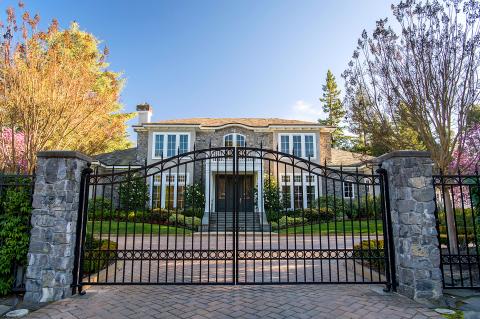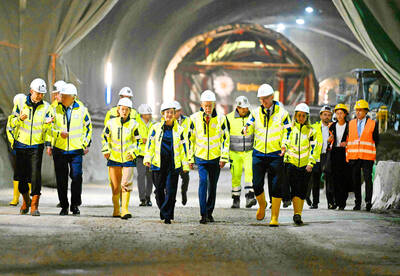You could easily drive through the leafy Silicon Valley suburb without realizing you were in the US’ richest neighborhood. From the road, it is all high brick walls and opaque gates.
It takes Google Maps to get a glimpse of what lies behind. Satellite images of Atherton, California — where the average household income just blew past US$500,000 — reveal the sprawling homes of tech billionaires and sports stars, studded with tennis courts and pools.
For the fourth straight year, Atherton topped Bloomberg’s Richest Places annual index. With an average household income of more than US$525,000, it became the first and so far only community to top the half-million-dollar mark since Bloomberg started compiling the index in 2017.

Photo: Bloomberg
At least some of the town’s Silicon Valley neighbors are more or less keeping up. Atherton is joined in the upper echelons of the Bloomberg list by Hillsborough (No. 3) and Los Altos Hills (No. 5), two more communities in the hi-tech corridor between San Francisco and San Jose.
Both have average incomes upward of US$400,000.
Elaine White, a real-estate agent and native of neighboring Redwood City, has watched the tech boom shape the region.
“Because of how big Facebook has gotten, and Google, we’ve kind of become this concept of the company town, where so many people work for these Silicon Valley companies,” she said.
In Atherton, the cheapest house on the market was listed for US$2.5 million, according to real-estate marketplace Zillow.com.
Numerous tech billionaires have called the town home — including former Google chief executive officer Eric Schmidt, Facebook Inc chief operating officer Sheryl Sandberg and Microsoft Corp late cofounder Paul Allen, whose former residence there was last week sold for more than US$35 million.
Golden State Warriors athlete Stephen Curry last year bought an Atherton estate for US$31 million.
In second place for the second straight year was Scarsdale, New York, less than 40km outside Manhattan, with an average US$452,000 in annual household income.
Also making the top 10 were a town near Denver, Colorado, two northern suburbs of Chicago and a wealthy enclave in Dallas, Texas.
In general, the east and west coasts dominated the top 100 list. California took up 23 places, while the tri-state area of New York, Connecticut and New Jersey accounted for 32, although that was down from 36 last year.
Middle America is slowly gaining some ground. States including Illinois and Minnesota added one new listing in this year’s index, while Texas gained two (Lucas at No. 73 and Alamo Heights at No. 75).
Altogether, 16 states are represented on the list, the same number as in previous years — suggesting that the concentration of wealth in certain regions remains largely unchanged over time.
Also, the richest communities continue to get richer. This year, to make the top 100, a neighborhood needed an average household income of US$220,000, up from US$209,000 last year.

CHIP RACE: Three years of overbroad export controls drove foreign competitors to pursue their own AI chips, and ‘cost US taxpayers billions of dollars,’ Nvidia said China has figured out the US strategy for allowing it to buy Nvidia Corp’s H200s and is rejecting the artificial intelligence (AI) chip in favor of domestically developed semiconductors, White House AI adviser David Sacks said, citing news reports. US President Donald Trump on Monday said that he would allow shipments of Nvidia’s H200 chips to China, part of an administration effort backed by Sacks to challenge Chinese tech champions such as Huawei Technologies Co (華為) by bringing US competition to their home market. On Friday, Sacks signaled that he was uncertain about whether that approach would work. “They’re rejecting our chips,” Sacks

NATIONAL SECURITY: Intel’s testing of ACM tools despite US government control ‘highlights egregious gaps in US technology protection policies,’ a former official said Chipmaker Intel Corp has tested chipmaking tools this year from a toolmaker with deep roots in China and two overseas units that were targeted by US sanctions, according to two sources with direct knowledge of the matter. Intel, which fended off calls for its CEO’s resignation from US President Donald Trump in August over his alleged ties to China, got the tools from ACM Research Inc, a Fremont, California-based producer of chipmaking equipment. Two of ACM’s units, based in Shanghai and South Korea, were among a number of firms barred last year from receiving US technology over claims they have

It is challenging to build infrastructure in much of Europe. Constrained budgets and polarized politics tend to undermine long-term projects, forcing officials to react to emergencies rather than plan for the future. Not in Austria. Today, the country is to officially open its Koralmbahn tunnel, the 5.9 billion euro (US$6.9 billion) centerpiece of a groundbreaking new railway that will eventually run from Poland’s Baltic coast to the Adriatic Sea, transforming travel within Austria and positioning the Alpine nation at the forefront of logistics in Europe. “It is Austria’s biggest socio-economic experiment in over a century,” said Eric Kirschner, an economist at Graz-based Joanneum

BUBBLE? Only a handful of companies are seeing rapid revenue growth and higher valuations, and it is not enough to call the AI trend a transformation, an analyst said Artificial intelligence (AI) is entering a more challenging phase next year as companies move beyond experimentation and begin demanding clear financial returns from a technology that has delivered big gains to only a small group of early adopters, PricewaterhouseCoopers (PwC) Taiwan said yesterday. Most organizations have been able to justify AI investments through cost recovery or modest efficiency gains, but few have achieved meaningful revenue growth or long-term competitive advantage, the consultancy said in its 2026 AI Business Predictions report. This growing performance gap is forcing executives to reconsider how AI is deployed across their organizations, it said. “Many companies